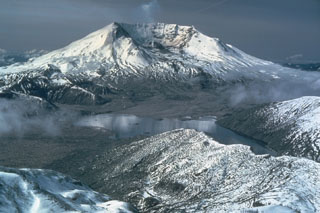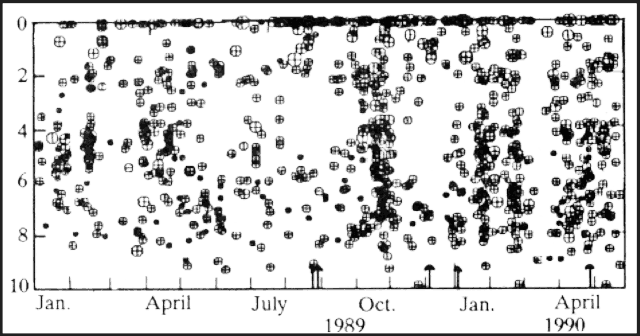Report on St. Helens (United States) — April 1990
Bulletin of the Global Volcanism Network, vol. 15, no. 4 (April 1990)
Managing Editor: Lindsay McClelland.
St. Helens (United States) Small apparent explosion signal on seismic records
Please cite this report as:
Global Volcanism Program, 1990. Report on St. Helens (United States) (McClelland, L., ed.). Bulletin of the Global Volcanism Network, 15:4. Smithsonian Institution. https://doi.org/10.5479/si.GVP.BGVN199004-321050
St. Helens
United States
46.2°N, 122.18°W; summit elev. 2549 m
All times are local (unless otherwise noted)
The Mt. St. Helens seismic network recorded an explosion-type seismic signal on 25 April at 0126. The seismicity appeared similar to that associated with minor tephra emissions on [6] December and 6 January (SEAN 14:11 and 14:12), but both amplitude and duration were much smaller on 25 April. No eruption plume was reported and fresh snowfall shortly after the episode obscured any material that may have been deposited. The number of tiny earthquakes (detected only by crater stations) remained elevated for ~18 hours after the activity, then returned to background levels. Periods of increased local seismicity have continued since late 1987 (figure 43 and SEAN 14:08 and 14:10).
Geological Summary. Prior to 1980, Mount St. Helens was a conical volcano sometimes known as the Fujisan of America. During the 1980 eruption the upper 400 m of the summit was removed by slope failure, leaving a 2 x 3.5 km breached crater now partially filled by a lava dome. There have been nine major eruptive periods beginning about 40-50,000 years ago, and it has been the most active volcano in the Cascade Range during the Holocene. Prior to 2,200 years ago, tephra, lava domes, and pyroclastic flows were erupted, forming the older edifice, but few lava flows extended beyond the base of the volcano. The modern edifice consists of basaltic as well as andesitic and dacitic products from summit and flank vents. Eruptions in the 19th century originated from the Goat Rocks area on the N flank, and were witnessed by early settlers.
Information Contacts: C. Jonientz-Trisler, University of Washington.


